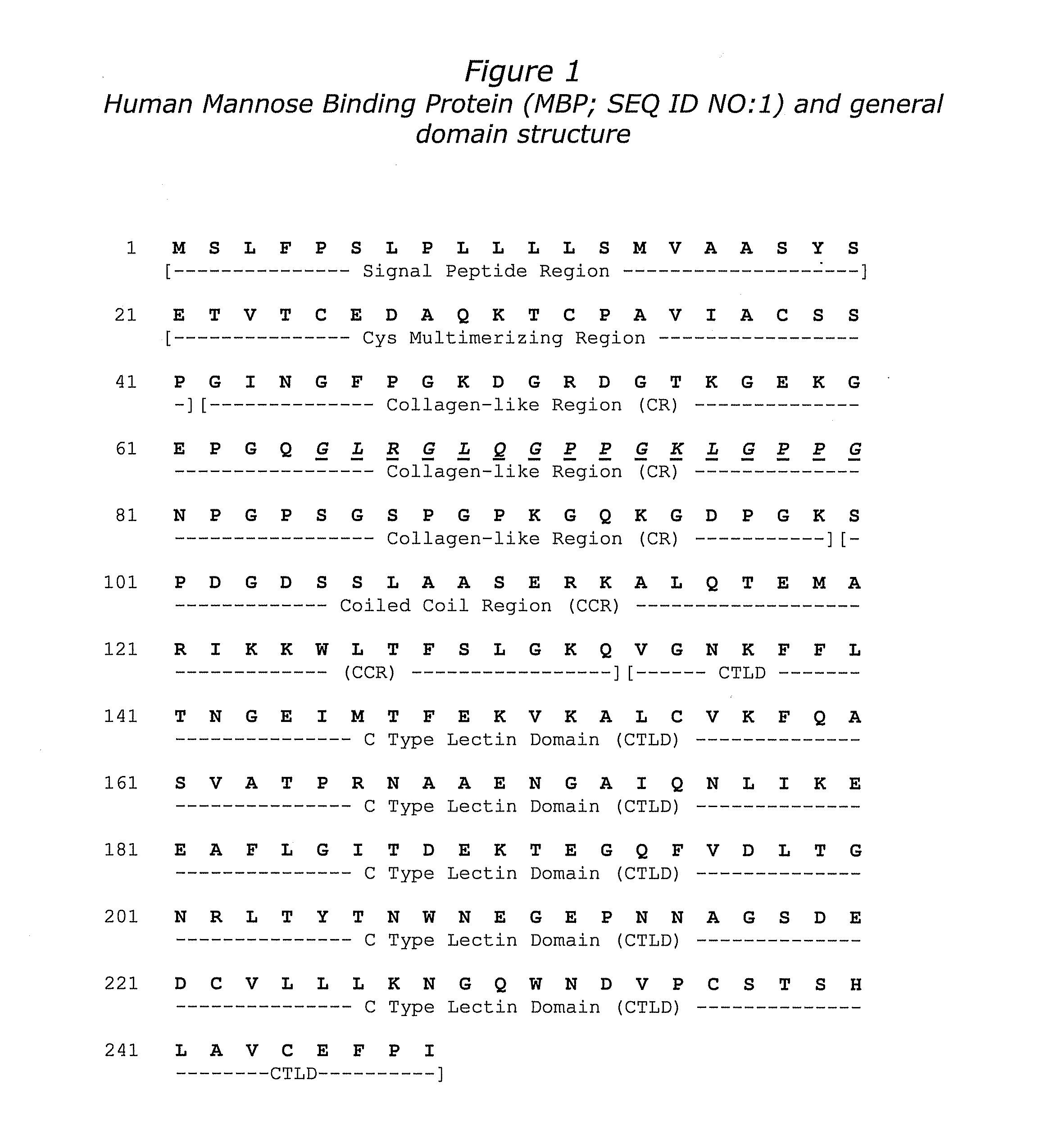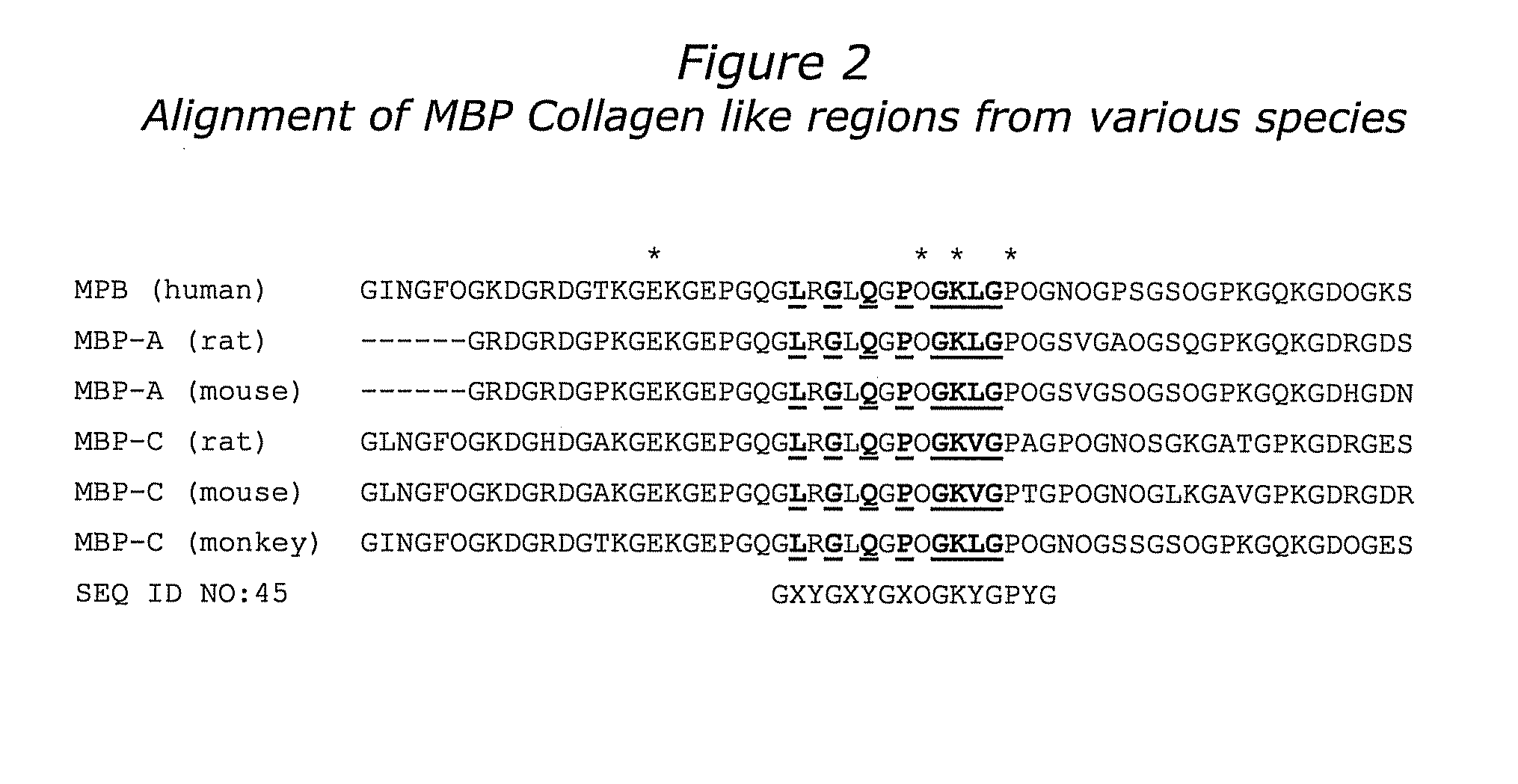Fusion Proteins of Mannose Binding Lectins for Treatment of Disease
a technology of fusion proteins and mannose binding lectins, which is applied in the field of fusion proteins of mannose binding lectins for disease treatment, can solve the problems of not being designed to initiate complement activation, triggering a cellular immune response, and high undesirable antibody production
- Summary
- Abstract
- Description
- Claims
- Application Information
AI Technical Summary
Benefits of technology
Problems solved by technology
Method used
Image
Examples
example 1
Construction and Expression in HEK293 Cells of Tagged and Untagged MBP-CD 209 CTLD Fusion Protein Expression Plasmid Clones
DC-SIGN (Dendritic cell specific ICAM-3 grabbing nonintegrin) is a type II transmembrane protein belonging to the C-type lectin family. The protein is expressed on the surface of dendritic cells (DC) in the periphery and participates in the primary contact between the antigen-presenting cells and resting T-cells in the lymphatic system via ICAM-3 on the T-cells. DC-SIGN also interacts with ICAM-2 on epithelial cells during migration of DCs to lymphoid tissues. DC-SIGN also binds strongly to the HIV envelope protein gp120 and facilitates viral infection in trans of CD4+ T-cells. The DC-SIGN protein consists of a short amino-terminal cytoplasmic tail, a transmembrane domain, a stalk of up to 7½ repeats, followed by a C-terminal C-type carbohydrate recognition domain (CRD). The stalk promotes the formation of tetramers (coiled coil). DC-SIGN binds to mannose- and f...
example 2
Analysis of the Various Tagged MBP-CD209 CTLD Fusion Proteins Binding to Either Immobilised HSA-Ley or Ley Expressing Cells of the Human Breast Cancer Cell Line SKBR-3
Supernatants from HEK293 cell culture transfected with tagged MBP / DC-SIGN CTLD expressing plasmids (pMBP / DC-SIGN CTLD-ABs, pMBP / DC-SIGN CTLD-ACs, pMBP / DC-SIGN CTLD-ADs, pMBP / DC-SIGN CTLD-ABsC, pMBP / DC-SIGN CTLD-ACsC, pMBP / DC-SIGN CTLD-ADsC, pMBP / DC-SIGN CTLD-FE, pMBP / DC-SIGN CTLD-GE, and pMBP / DC-SIGN CTLD-HE) were analyzed for ability to bind to immobilized Ley coupled to human serum albumin (HSA) or to Ley expressing human SKBR-3 breast cancer cells after four days of transient expression. The MBP / DC-SIGN CTLD ABs and MBP / DC-SIGN CTLD ABsC fusion proteins were also tested for ability to bind to MCF-7 human breast cancer cells, LNCap prostate cancer cells, and A431 skin epithelial squamous carcinoma cells.
In the first assay 0.5 μg Ley-HSA (IsoSep, Uppsala Sweden) per well in PBS (10 mM sodium phosphate pH 7.4, 100 mM N...
example 3
Purification of MBP / DC-SIGN CTLD Derivatives Using Mannan-Agarose Affinity Chromatography
Stable clonal cell lines expressing MBP / DC-SIGN CTLD ABs, MBP / DC-SIGN CTLD ABsC, or MBP / DC-SIGN CTLD ABsC0 fusion derivatives and a stable cell line population expressing the MBP / DC-SIGN CTLD ABs0 fusion derivative were established by transfection of HEK293 cells with either super coiled or linearized plasmid DNA, and different concentrations of plasmid DNA. Stable cell lines were obtained by seeding cells at various concentrations and increasing selection pressure using zeocin. Several clones were propagated and the culture supernatant were analysed for fusion protein production using the immobilised Ley HSA ELISA assay described in Example 2. MBP / DC-SIGN CTLD derivatives from the supernatant of stably transfected clones were affinity purified using mannan-sepharose as described in the following paragraph.
The MBP / DC-SIGN CTLD expression supernatant (ca. 2.5 L) was filtered, supplied with 250 mL...
PUM
| Property | Measurement | Unit |
|---|---|---|
| Composition | aaaaa | aaaaa |
| Surface | aaaaa | aaaaa |
| Chemotherapeutic properties | aaaaa | aaaaa |
Abstract
Description
Claims
Application Information
 Login to View More
Login to View More - R&D
- Intellectual Property
- Life Sciences
- Materials
- Tech Scout
- Unparalleled Data Quality
- Higher Quality Content
- 60% Fewer Hallucinations
Browse by: Latest US Patents, China's latest patents, Technical Efficacy Thesaurus, Application Domain, Technology Topic, Popular Technical Reports.
© 2025 PatSnap. All rights reserved.Legal|Privacy policy|Modern Slavery Act Transparency Statement|Sitemap|About US| Contact US: help@patsnap.com



